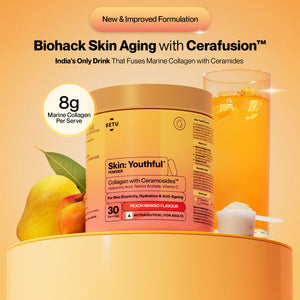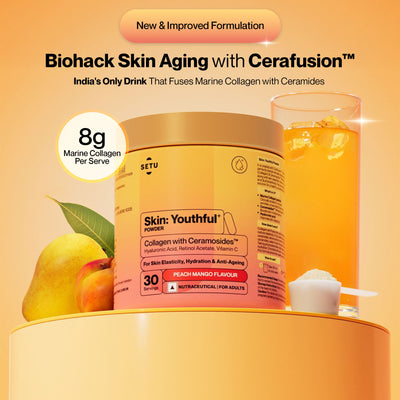From Acne Scars to Fine Lines: How Collagen Helps Your Skin Heal and Rebuild
30 Jun 2025
When you look in the mirror, what do you see? Perhaps the remnants of teenage acne battles etched into your cheeks, or maybe those subtle lines that seem to deepen with each passing year. Whether you're dealing with acne scars that tell the story of your past or fine lines that hint at your future, there's one protein that plays a starring role in your skin's ability to heal, rebuild, and maintain its youthful appearance: collagen.
Understanding collagen's remarkable ability to transform damaged skin isn't just about vanity, it's about empowering yourself with knowledge that can genuinely improve your skin's health and appearance. Let's dive deep into the science of how this incredible protein works to address two of the most common skin concerns that affect millions of people worldwide.
The Foundation of Healthy Skin: Understanding Collagen
Collagen is far more than just a buzzword in skincare marketing. It's the most abundant protein in your body, making up approximately 75% of your skin's dry weight. Think of collagen as the scaffolding that holds your skin together, providing structure, strength, and elasticity that keeps your complexion smooth, firm, and resilient.
Your skin contains several types of collagen, but Type I collagen is the most prevalent, forming the dense network of fibers that give your skin its tensile strength. Type III collagen works alongside it, providing flexibility and support to blood vessels. Together, these proteins create the foundation upon which healthy skin is built.
Unfortunately, collagen production naturally declines as we age, dropping by approximately 1% each year after age 25. This gradual decrease is what leads to many visible signs of aging, but it also affects your skin's ability to heal from damage like acne scars.
The Acne Scar Story: When Healing Goes Wrong
Acne scars form when inflammatory acne lesions damage the skin's collagen structure. When a pimple forms, your body's immune response kicks into high gear, sending white blood cells to fight the infection. This inflammatory process can damage the surrounding collagen fibers, and when the healing process doesn't restore the collagen network properly, scars form.
There are several types of acne scars, each reflecting different patterns of collagen damage and repair. Ice pick scars are narrow, deep indentations that occur when collagen loss creates a punched-out appearance. Rolling scars develop when fibrous bands of scar tissue pull the skin downward, creating wave-like indentations. Boxcar scars appear as broader depressions with sharp edges, typically resulting from widespread collagen destruction.
The key to understanding acne scar treatment lies in recognizing that these marks aren't just superficial blemishes—they're areas where the skin's collagen foundation has been permanently altered. This is why topical treatments alone often fall short, and why treatments that stimulate new collagen production tend to be more effective.
Fine Lines: The Gradual Erosion of Youth
Fine lines tell a different story than acne scars, but collagen still plays the central role. As collagen production decreases and existing collagen fibers become damaged by factors like UV exposure, pollution, and repetitive facial expressions, the skin begins to lose its ability to bounce back from daily stresses.
The first fine lines typically appear in areas where the skin is thinnest and most mobile—around the eyes (crow's feet), between the eyebrows (frown lines), and around the mouth. These areas experience constant movement, and as collagen support weakens, the skin can no longer fully recover from the folding and stretching that occurs with facial expressions.
UV damage accelerates this process significantly. Ultraviolet radiation breaks down collagen through a process called photoaging, where UV rays penetrate the skin and damage the collagen matrix. This is why sun protection is so crucial for preventing premature aging—it's literally protecting your skin's collagen foundation.
How Collagen Rebuilds and Repairs
The remarkable thing about collagen is that your skin never completely loses its ability to produce new collagen fibers, even as you age. The process just becomes slower and less efficient. Understanding how to stimulate and support collagen production is key to addressing both acne scars and fine lines.
When your skin is injured or damaged, a complex healing cascade begins. Specialized cells called fibroblasts spring into action, producing new collagen to repair the damage. However, this repair process isn't always perfect. Sometimes too little collagen is produced (leading to atrophic scars), sometimes too much (leading to hypertrophic or keloid scars), and sometimes the new collagen is organized differently than the original tissue.
The goal of modern collagen-stimulating treatments is to encourage controlled, organized collagen production that improves skin texture and appearance. This is why treatments like microneedling, laser therapy, and radiofrequency work so well—they create controlled micro-injuries that trigger the skin's natural healing response, encouraging new collagen formation in a more organized pattern.
Proven Methods to Boost Collagen Production
Several approaches have proven effective at stimulating collagen production and improving both acne scars and fine lines. Professional treatments often provide the most dramatic results, but there are also at-home strategies that can support your skin's collagen production.
Microneedling creates tiny punctures in the skin using fine needles, triggering the wound healing response and encouraging new collagen formation. Studies show that a series of microneedling treatments can significantly improve acne scar appearance and skin texture. The controlled injury stimulates fibroblasts to produce new collagen, gradually filling in depressed scars and improving overall skin quality.
Laser treatments work by delivering controlled energy to the skin, creating thermal injury that stimulates collagen remodeling. Fractional lasers are particularly effective because they create treatment zones surrounded by healthy tissue, promoting faster healing and more effective collagen regeneration.
Chemical peels remove damaged surface layers of skin while stimulating deeper collagen production. Deeper peels can be particularly effective for acne scars, as they encourage significant collagen remodeling during the healing process.
Topical retinoids, derivatives of vitamin A, are among the most scientifically proven ingredients for stimulating collagen production. They work by increasing cell turnover and encouraging fibroblasts to produce new collagen. Regular use of retinoids can improve both acne scars and fine lines over time.
Nutritional Support for Collagen Health
While topical treatments and professional procedures are important, supporting your skin's collagen production from within is equally crucial. Your body needs specific nutrients to produce healthy collagen, and deficiencies in these nutrients can impair the healing process.
Vitamin C is essential for collagen synthesis, as it's required for the enzymatic processes that create stable collagen fibers. Without adequate vitamin C, your body cannot produce strong, healthy collagen. Foods rich in vitamin C include citrus fruits, berries, leafy greens, and bell peppers.
Amino acids like proline, glycine, and hydroxyproline are the building blocks of collagen. These can be obtained through protein-rich foods or collagen supplements like Skin: Youthful Marine Collagen. Bone broth, fish, eggs, and legumes are excellent sources of these amino acids.
Zinc plays a crucial role in collagen synthesis and wound healing. Deficiency in zinc can impair your skin's ability to heal from acne and other damage. Good sources include oysters, pumpkin seeds, and lean meats.
Setting Realistic Expectations
While collagen-stimulating treatments can produce remarkable improvements in skin appearance, it's important to have realistic expectations. Collagen remodeling is a gradual process that takes time—typically several months to see significant improvements. Deep acne scars may require multiple treatment sessions and combination approaches to achieve optimal results.
Fine lines often respond more quickly to collagen-stimulating treatments than deep acne scars, but even fine lines require patience and consistent treatment to see meaningful improvement. The key is understanding that you're working with your skin's natural healing processes, which can't be rushed.
The Path Forward
Your skin's relationship with collagen is a lifelong journey. Whether you're dealing with acne scars that have bothered you for years or fine lines that are just beginning to appear, understanding how collagen works gives you the power to make informed decisions about your skincare routine and treatment options.
The most effective approach often combines multiple strategies: professional treatments to stimulate significant collagen remodeling, consistent at-home care with proven ingredients like retinoids, proper sun protection to prevent further collagen damage, and nutritional support to ensure your body has the building blocks it needs for healthy collagen production.
Remember that every person's skin is unique, and what works best for one person may not be ideal for another. Consulting with a qualified dermatologist or skincare professional can help you develop a personalized approach that addresses your specific concerns and skin type.
The journey from damaged to healthy skin isn't always quick or easy, but with patience, consistency, and the right approach, collagen's remarkable healing power can help transform your skin, giving you not just better appearance, but also the confidence that comes with healthy, resilient skin.
Skin: Youthful with Marine Collagen & Ceramosides™
- ₹1,694
- ₹1,694
-
₹2,200 - ( 23% OFF)
Categories
- Choosing a selection results in a full page refresh.
- Press the space key then arrow keys to make a selection.
this is the sidecart













